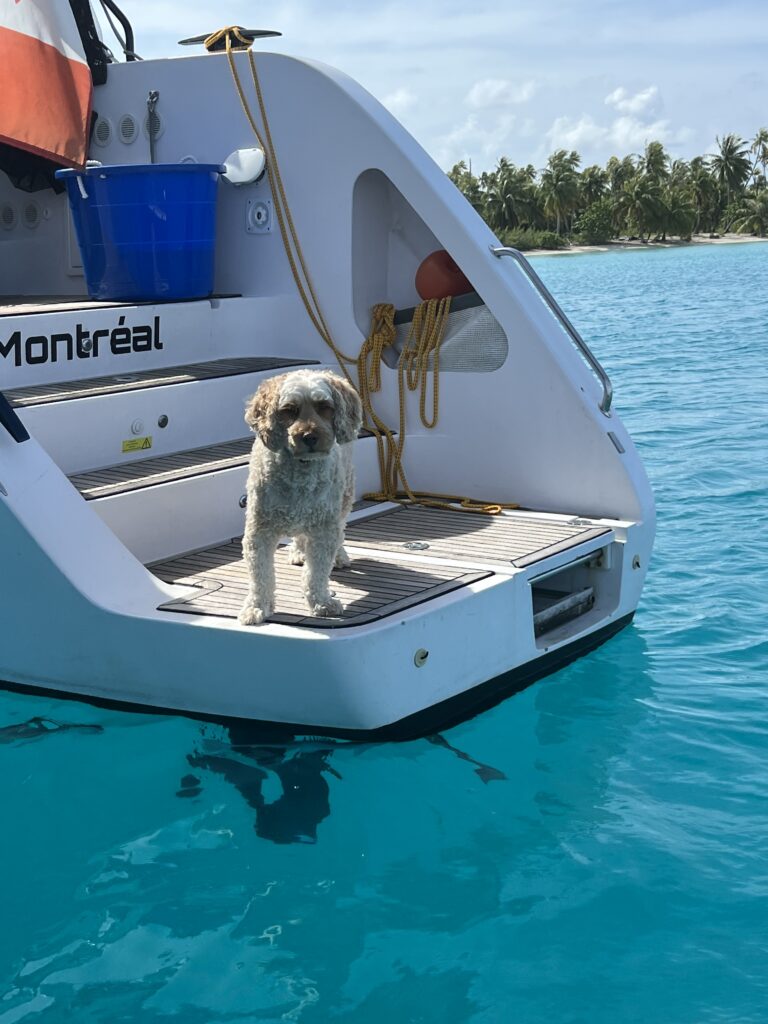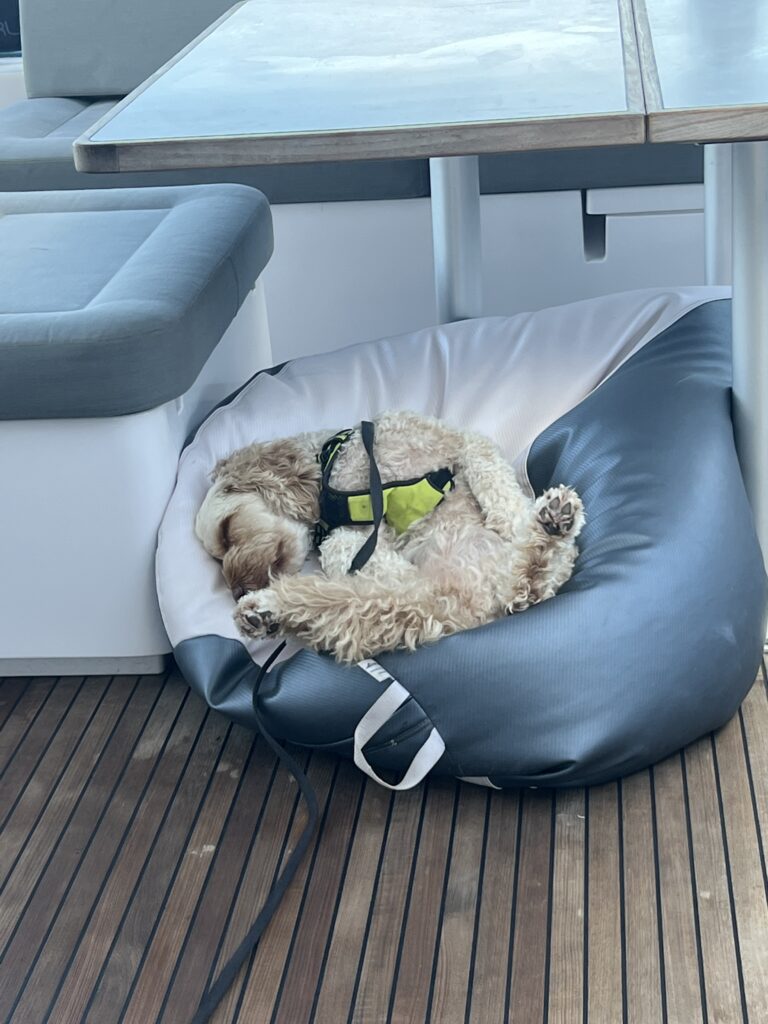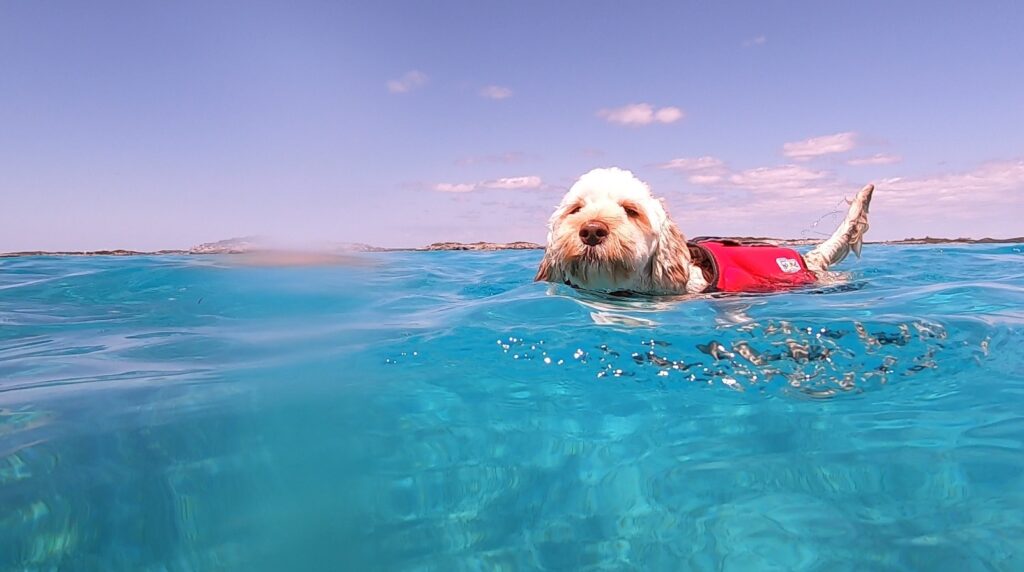Notes after sailing more than halfway around the world
BioTrek is now in Cape Town, South Africa and we are just loving it here! We have sailed about 40,000 miles with BioTrek, all with our dog Tiller on board. You can follow our adventures on our YouTube channel @biotreksailing.
I decided to write a blog about sailing with pets because I am often asked specific questions about sailing with a pet. Below are my opinions, knowing that your situation, dear reader, may well be different from ours. For those who sail without pets, you will find it is not as easy as it seems. For those who sail with pets, I hope you find some tidbits of interest.

Advice to anyone planning to sail with a pet
We sail with our dog Tiller who only knows BioTrek as her home. Our decision to bring a canine companion with us to sail around the world led us to choose a labradoodle, a breed known for its love of swimming and non-shedding fur. We also opted for a dog with a manageable weight for lifting, and Tiller weighs 15 kg. There are instances when you may need to carry your dog off the boat, such as at a fixed dock during low tide. Or, you may need to carry your pet up and down a ladder when the boat is being hauled out.
Tillers traits have certainly made sailing with a dog easier than it might be with some other breeds. A smaller dog is a definite advantage. It is important to recognize that not all dogs are cut out for life on the water, just as not all humans are. Some dogs, like Tiller, do not experience seasickness, but this may not be the case with another breed or with an older dog. Just like humans, not all dogs will adapt well to living on a boat and sailing in rough seas.
Living aboard
If you take your pet sailing with you, the pet needs to be able to live on the boat without going ashore for very long periods of time. This requirement may arise due to various factors, including adverse weather conditions, the absence of a suitable landing spot for a dinghy, or when voyaging to foreign countries.
We are often asked the question “where does she go?” Tiller is female, so she squats to pee rather than lifting a leg, and we taught her to pee on command. At sea she urinates on a boot tray with a raised edge ensuring that the urine is contained on the tray. Afterward, we easily lift the tray and toss the urine overboard followed by washing the tray with the back transom shower and stowing it nearby.
We started training Tiller with artificial grass placed on the tray. With the grass on a lanyard, it could be thrown overboard for cleaning, and then rinsed in vinegar water every now and then. However, with this method I constantly needed to warn guests not to step on the grass! Now, Tiller simply pees on command on the tray and communicates her need in a unique way if we happen to forget.
Bowel movements are different because dogs don’t like to go where they urinate. Tiller generally does this near the diesel fuel inlet. If seas are too rough to go forward, she simply goes at the end of her leash.
Sailing
Tiller is ALWAYS attached to the boat when sailing offshore. We use a harness to a fixed long leash when at sea so that if she were to fall overboard, she would dangle from her harness, not from her neck. Even a well-trained dog can forget the rules with enough distraction. Tiller is distracted by flying fish on deck, especially at night, by dolphins, or by a fish being reeled in. To keep her safe from being swept overboard, she is tethered to a permanent leash in the outside cockpit. We also keep a short leash tied to the table inside the boat for use when we are doing sail maneuvers. We don’t want her leash to get caught in a line during a gybe or when we are rolling sails.

Traveling abroad
In many countries such as the St. Lucia, Antigua, and French Polynesia, pets are not allowed to leave the boat until being checked by a government veterinarian. In the case of French Polynesia, the government veterinarian is based in Tahiti which means that for vessels following trade wind routes, pets must remain onboard until they reach Tahiti.
Certain countries, such as Tonga and Fiji, prohibit pets from going ashore so the pet must remain on board the boat for the duration of the stay. The entire South Pacific is a rabies-free area of the world, and authorities in most South Pacific countries are quite strict about pets to ensure the country stays rabies-free. The only way to accurately detect rabies in an animal is to examine brain histology, and that can only be done by euthanizing the pet and examining the brain. Not obeying rules in the South Pacific can have grave consequences for your pet, including the potential euthanasia of the pet if caught going ashore when it is forbidden.
Fiji, on the other hand, requires a substantial bond, reportedly close to $750 USD, as a guarantee that your pet will remain on the boat. Instances have been reported where individuals who took their pets ashore, were reported by locals, and consequently forfeited their bond as a penalty. It is crucial that your pet will be able to remain on the boat without going to shore to be able to follow the regulations and requirements of each country during your sailing adventure.
You can’t see it all.
If you sail around the world with a dog, you must be willing to skip certain countries, or certain regions. Pets on yachts are simply not allowed in certain places and certain countries, or it is just too complicated to get permission to enter certain countries. Example countries where dog importation by yacht is not allowed are St. Vincent and the Grenadines and Australia. Recently, the Galapagos Islands have joined the list of restricted areas due to an incident where a yacht owner took their dog ashore without authorization. New Caledonia presents its own challenges because of the extensive testing requirements for pet entry. If traveling from French Polynesia where such testing can be done, you are not allowed to stop at another country en route making the 4000-mile voyage quite long. Upon arrival in New Caledonia, a mandatory 10-day quarantine in a government facility is enforced, a situation that another boat crew informed us was distressing for their pet. Quarantine is also required in New Zealand, but the facilities are reputed to be more accommodating. French Polynesia required careful attention to all the right tests and documentation, by contrast with the Caribbean French Islands where traveling with a dog is quite easy.
Your pet must have all the required chips, vaccinations, and tests for each country.
Keeping up with the country-to-country requirements for pet entry can be complicated. It is difficult to find information online because most information is typically only relevant for pets traveling by airplane. The best source of information is directly contacting government officials or by speaking with other cruisers who travel with pets. There are services for super yachts that have pets on board that may also be helpful.
For your pet to enter a foreign port, most countries require a rabies antibody titer test, which is a test that ensures that the rabies vaccination is effective. It requires a blood draw by a veterinarian and the blood sample must be shipped by the veterinarian to an approved government lab for testing. This requirement underscores the importance of advance planning due to the potentially lengthy testing process, often taking a month or longer. For example, in Tahiti, the blood draw can be done by a local vet, but the sample is sent to a government laboratory in France. If you plan to sail the South Pacific, this testing must be done once a year. Therefore, it is important to plan to be in a port where such testing is possible before the dog’s current certificate expires.
It is important to be aware of rules regarding rabies vaccination for each country on route. For example, French Polynesia does not accept the 3-year vaccine normally given in the USA and your pet may be subject to a 6-month on-board quarantine if your dog’s current rabies vaccination is not acceptable to French Polynesia officials. Panama is a rabies endemic region and French Polynesia follows the rules of the World Organization for Animal Health (WOAH) that requires a 6-month quarantine for any animal that may have had potential contact with rabies, meaning, has passed through Panama. Therefore, rabies compliance needs to be done before reaching Panama for those wishing to cross the Panama Canal and travel to the South Pacific.
Worldwide, 99% of human rabies cases are due to dog bites, and rabies prevention during dog importation is taken very seriously in all rabies-free countries, and rabies controlled Western countries. The list of country rabies status is available on the WOAH web site. For rabies-free territories such as Hawaii, American Samoa and French Polynesia it is important to contact the government officials several months in advance so that they can look at the pet vaccination record and advise if additional vaccinations are required. We required re-vaccination of our dog for rabies in Tahiti despite valid rabies vaccination from the USA and good titer test results. Similarly, we encountered another boat with a dog whose rabies titer test had expired by just one week, leading to a three-month quarantine, re-vaccination, and re-testing.
Vaccination for leptospirosis is not typically given to dogs in western countries but is essential for traveling pets to protect from this diseases carried by rats. It is a disease that is prevalent in tropical countries such as Vanuatu and Indonesia. Our dog fell sick with leptospirosis in Indonesia despite being vaccinated. Fortunately, the vaccination made the illness less severe, likely preventing a life-threatening situation.
Most difficult aspect of traveling with a pet.
Lots of paperwork.
Many countries require the submission of dog-related documents well in advance of your arrival in port. Among these requirements is often a certificate of good health issued by a veterinarian from the country of departure. Usually, the certificate of good health must be issued within a specific timeframe just before your departure. That means a final vet visit shortly before the clearing out process.
There are many places where you cannot walk your dog.
There are numerous places where taking your dog for a walk may not be feasible. Even in locations where pets are permitted on land, unfriendly local dogs can pose a problem. Some countries have a dog problem with homeless dogs that can be quite aggressive to other dogs. While some marinas offer pleasant spots for dog walks, venturing further can pose difficulties.
It is important to be aware that there are some cultures where there are religious restrictions to interacting with dogs or where people are frightened of dogs. If a devote Muslim is licked by a dog, they must complete a complex washing procedure. Therefore, it is important to keep the pet on a leash to avoid unwanted interactions with local people.
Finding a dog sitter is not always easy.
Excursions to visit a new country are always fun, but you often cannot take your pet along. You may need to restrict visiting the local attractions to short day trips. If you want to do longer excursions, you may need to find a dog sitter. The availability of at-home boarding care for your pet tends to be relatively straightforward in dog-friendly places like Tahiti or Cape Town. However, it can pose a significant challenge in other destinations.
Animals can get sick.
It’s essential to establish a reliable relationship with a veterinarian in your home country whom you can consult for guidance while traveling. Additionally, having antibiotics on hand for your pet is critical. Generally, the antibiotics in a cruisers offshore medical kit can be used, with appropriate dose modification upon consultation with your dog’s doctor.
Like humans, dogs may not always drink enough water while at sea, potentially leading to urinary tract infections. To prevent this, I prepare homemade chicken broth to help keep my dog hydrated during long passages or on days that are particularly hot. This proactive approach ensures our dog stays well hydrated.
Benefits of traveling with a dog.
Traveling with a dog offers a unique way for us to connect with people and immerse ourselves in local cultures. During our travels in different countries, our dog serves as a fantastic conversation starter, allowing us to easily engage with curious locals or with other dog owners who are out walking their dogs. For instance, when we visited Vanuatu, children were particularly intrigued by our fluffy dog, often gathering around us to ask questions and take turns petting the dog.
Our dog is trained not to bark needlessly, such as when a dog ashore barks at night. But a dog’s instinct is to protect the home, and our dog alerts us to friends and to strangers who stop by the boat. Nobody approaches our boat without the dog knowing, not even a swimmer coming close to the boat. On one occasion, my husband detected a masked man ready to board the boat and the dog’s warning bark scared him away.
In calm anchorages and places where the dog cannot go to shore, I enjoy paddle boarding with my dog. Our excursions together often lead to comments and friendly conversations with other cruisers who are curious about paddle boarding with a dog. We easily meet other cruisers traveling with their pets and often become fast friends as we share experiences about traveling with a pet. And when dogs become friends, it is always fun to let dogs have play time together.

Our dog’s presence deters birds who can make a mess on the boat when they choose a place to perch. Our dog also deters pests like rats, which troubled neighboring boats in Indonesia but never became an issue for us. Traveling with our dog not only enriches our experiences but also enhances our safety and comfort in foreign ports.

Very interesting article. I’ve traveled coastal with cats. I now have a 4kg Maltese. What happens in countries where dogs are not allowed, like Australia? Can you commit to keeping the dog aboard, or do they take the dog for quarantine? Same question for NZ.
I’m also surprised that Tahiti doesn’t accept the 3-year rabbies shot. We currently live in France, and that’s the one the little guy got. Maybe they’d accept à French one, as they are supposedly (ahah) French…
I found this article via your YouTube post. I also follow Cat Great Circle, and Saga, but they don’t have dogs…
Tiller also gives great companionship for guests on board!
Tiller is also a great model for quick sketches. For a more elaborate rendering, he does have one very successful pose: I found that he can hold a very touching sleeping attitudes for long minutes, even on rough seas.